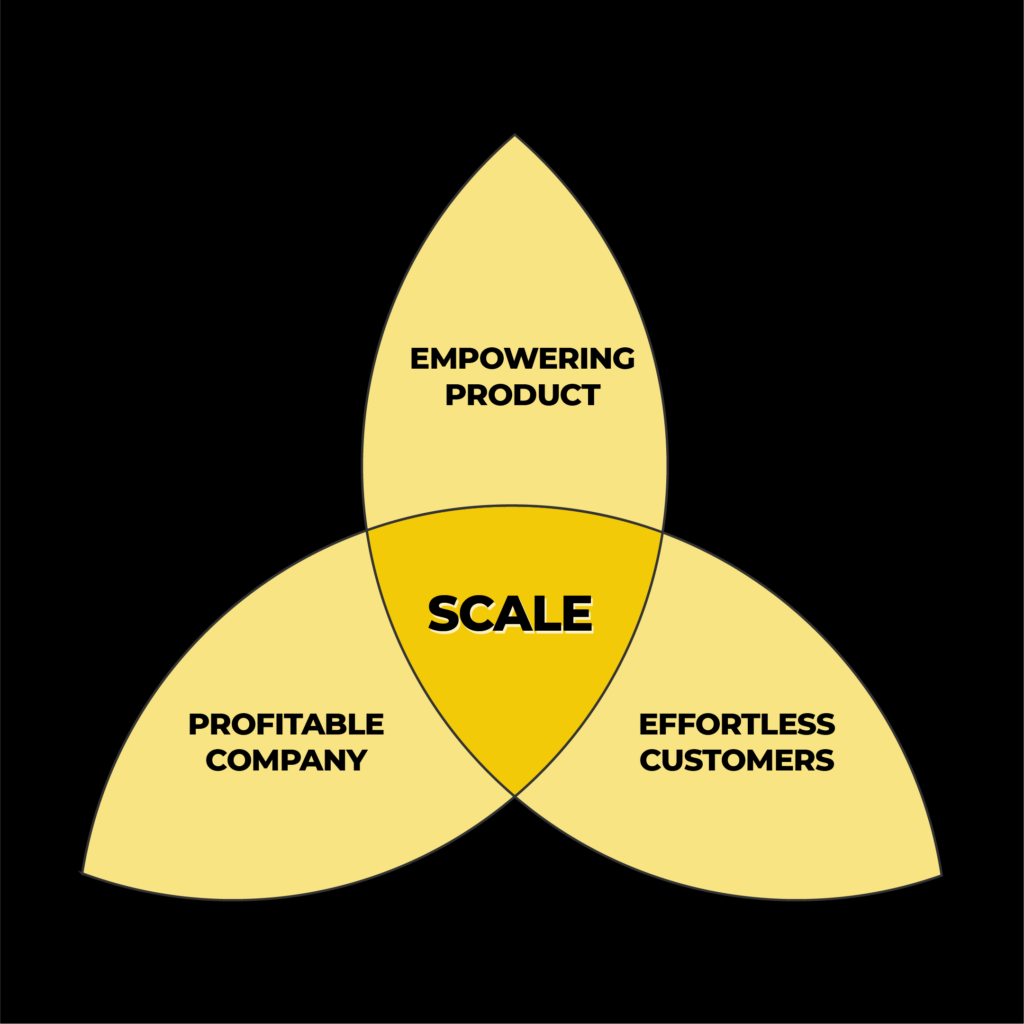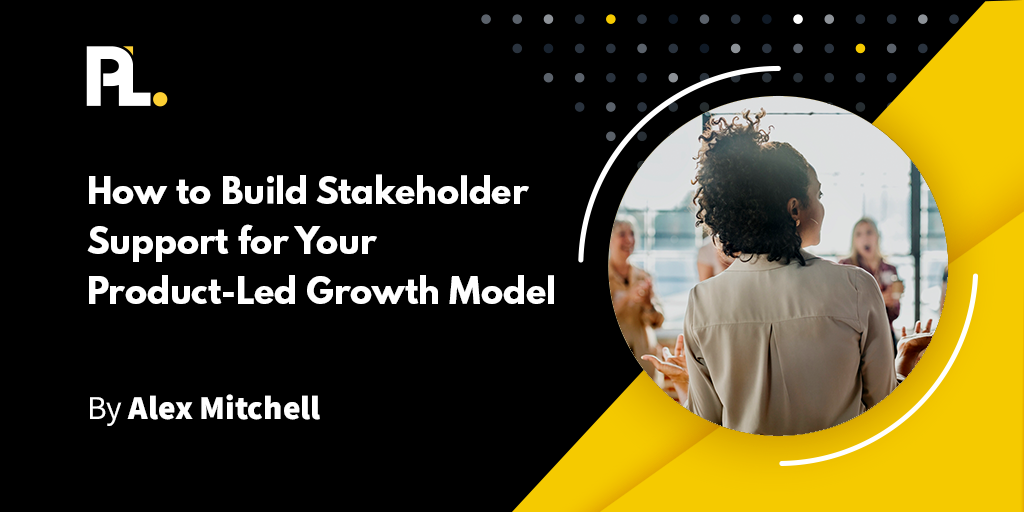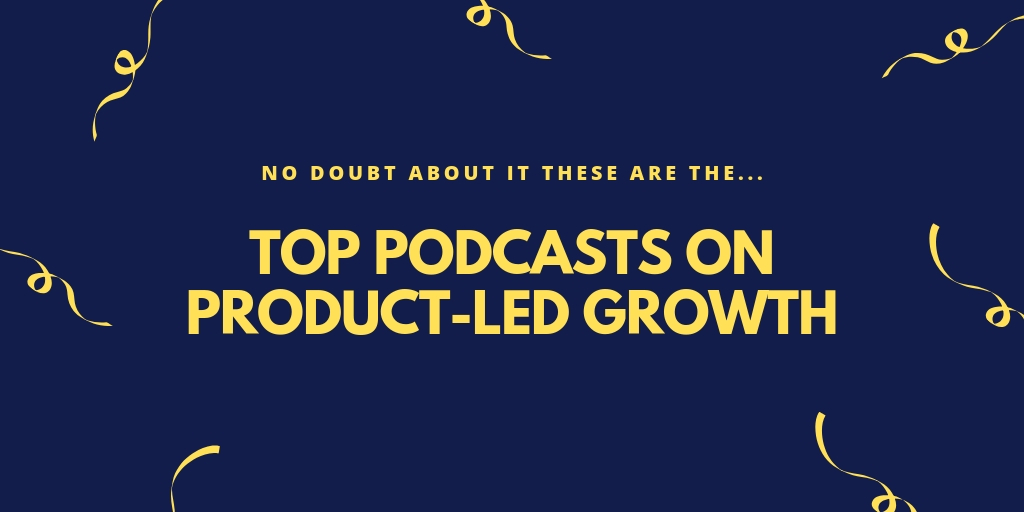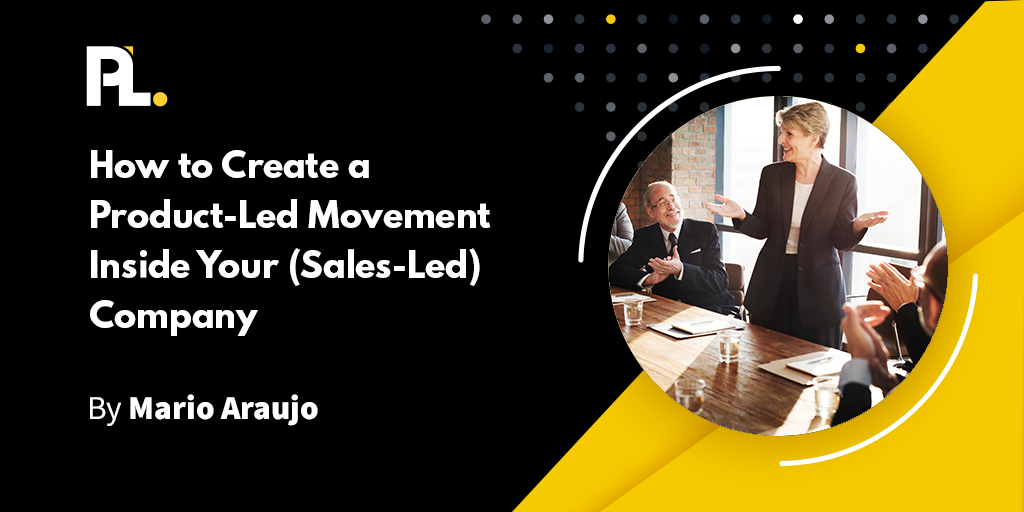
Most entrepreneurs I talk to want to build and scale a product-led business.
But where do you start?
- Do you start with improving your onboarding experience?
- Do you optimize your pricing model?
- Do you focus on simplifying your strategy?
As you can probably guess by these questions, the answer is a lackluster “it depends.”
That’s okay, though.
The ProductLed System™ I’m about to share with you takes all the major components of building a product-led business and helps you spotlight what you should focus on first.
Right now, you’re probably worrying needlessly about a hundred different things yourself. Let’s try to remove some of them by looking at a wide-angle view of your business and its components.
*If you're more of a visual learner, be sure to check out the Product-Led Growth Masterclass here.
Introduction To the ProductLed System™️
Hi, I’m Wes Bush, and I’m here to make your life as a CEO easier. I’m going to show you, step-by-step, how we drive predictable, profitable growth for 7-figure product-led businesses around the world – without the chaos and overwhelm that most founders deal with. Yes, you’re going to be able to GROW without the constant grind…
If you follow the ProductLed System™.
In the next 20 minutes, I’m going to show you:
- The 3 phases to unlocking exponential growth
- The nine components that are holding you back from scaling
- The (very important) order of attack to gain the most traction
My goal is to help you scale your self-serve revenue faster without working harder.
In my new book, The Product-Led Playbook, I reveal the nine key components of The ProductLed System and show you exactly how to master them to grow your ARR to the millions. Packed with case studies and templates, it's the go-to manual you need to build a successful product-led business.
Before we start, let’s cover three critical points…
There is a pivot point in every successful business owner’s life. Where growth by hustle is replaced by growth through leverage.
And my mission is to help you make that pivot.

But before you learn, you must be willing to unlearn.
A lot of what I’ll show you may be at odds with what you’ve learned so far in your journey. It goes against everything the “gurus” would have you believe.
Our approach is extremely logical, and you’ll come to see that. I expect you to have lots of “aha!” moments.
It is, however, going to be about the proven principles to scale for long-term success. It is going to be about simplicity and helping you achieve your big goals without the grind.
So if you’re ready to make your life easier — and learn a new, better, simpler way to scale — then let’s get started.
Here’s the first point you need to understand. Write this down. It seems easy, but 99% of entrepreneurs don’t really understand this.
#1: Synergy is a precursor to scale
We all know 1+2 = 3.
Yet, with synergy sometimes 1+2 can equal 10.
How?
When you combine two or more complimentary elements, the combined effect can be greater than the sum of its parts.
We know this to be true.
Not in math but in the practical world.
Take an automobile, for instance. It has 1,000+ parts. Each on its own is relatively inexpensive and doesn’t hold much value to the everyday consumer. Yet, put those same 1,000+ parts together and build a Ferrari. Those parts have created a synergy that holds incredible value and utility.
The same truth holds true for your business.
Your business has hundreds, if not thousands, of moving pieces.
Creating synergy is daunting.
Yet, if you zoom out and look at your business, there are only three parts you need to align to create synergy:
- Your company – which represents what you’re really good at.
- Your product – which signifies how you create a ton of value.
- Your customer – which represents who you serve best.

Yet, how often do we find ourselves servicing non-ideal customers and creating features that don’t align with what our company is really good at building?
Every time we make one of these blunders, we lose our synergy, and scaling becomes harder.
Creating synergy starts with being self-aware as a business owner and getting clear on these three questions:
- What you’re really good at?
- Who do you serve best?
- How do you create a ton of value?
Companies that are clear on these three questions create 10x synergy that helps them scale.
Your struggling company turns into a profitable company.
Your okay product turns into an empowering product.
Your pain-in-the-butt customers are replaced with effortless customers.

And scaling, well, that becomes a whole lot easier once you have synergy.
Yet, even though synergy is a precursor to scale, if you don’t master engagement, your product-led business is doomed.
#2. “How” you sell is just as important as “what” you sell
To sell anything, you need these three growth pillars:
- Acquire = Getting people to find out about your business.
- Monetize = Converting people to customers and growing customer value.
- Engage = Delivering value through your product/service.
With the introduction of product-led growth (PLG), have the fundamentals of business changed?
The answer to the question is no.
So, what has changed with the introduction of PLG?
You need to prioritize one of the fundamental elements of doing business earlier.
In a product-led model, you need to engage before you monetize.

Here’s why…
What did you do the last time you installed an application on your phone and couldn’t figure out how to use it or get to value?
If you’re like most people, you didn’t use it again.
Or if you’re a minimalist like me, you just uninstalled it.
We’re not ruthless people; it’s just how it works.
If you don’t create an experience that engages users, it’s game over.
Engagement is the lifeblood of a product-led business.
Yet, on the flip side of this question.
What did you do the last time you installed an application on your phone and couldn’t believe how much value you got from it?
If you’re like more people, you kept using it.
And if you really enjoyed using it, you might have purchased it.
This brings home the secret to product-led growth.
Your users’ success will become your success.
To make your users successful, you need to do three things well:
- Acquire — the “right” users
- Engage — by creating incredible user value
- Monetize — by growing customer value
When you master these three growth pillars and prioritize engagement before monetization, you truly change “how” you sell for the better.
But rolling out these changes in your business can be overwhelming. Most entrepreneurs waste a lot of time just wondering where to get started. Luckily, there’s an order to approach this.
#3: There is a very strategic order to growth.
What you focus on is important, sure. But even more important is the order you work on those problems.
For example:
If you try to fix your onboarding before you’re clear on who your ideal user is, you’ll waste your time and not get a good ROI.
Trying to hire before you have customer traction? You’ll burn your runway and have little to show for it.
The good news: the strategic way I’m going to show you will make growth faster and easier.

This is ALL possible if you follow the ProductLed System™.
The ProductLed System is your roadmap to scaling your product-led business and becoming the obvious choice in your market.
It focuses on nine key components for scaling a product-led business. These components embody the 80/20 Pareto principle: 80% of your results will come from just 20% of your efforts. By mastering these components, you'll realize your vision faster without working harder.
While the system is straightforward to understand, it requires time and effort to implement effectively within your organization. It didn’t appear overnight; it’s the culmination of over 10,000 hours of planning, teaching, coaching, and solving leadership challenges.
This system delivers three core outcomes:
- Effortless ARR: You built a product that can sell itself
- Lean Scale: You have a high revenue per employee.
- Durable Growth: Your business is growing month-over-month.
It’s structured around three crucial stages, each with three distinct components. These components build on one another in a specific order, ensuring that your efforts yield maximum impact. For instance, optimizing onboarding without a clear offer is futile, and scaling your team without customer traction is a drain on resources.
It’s important to note that this system is not a one-time fix. The ProductLed System is a living, breathing framework designed to evolve with your business. At a minimum, you should go through a full cycle of the system once a year. For fast-growing companies, up to four cycles a year may be necessary.
And it all starts with mastering the fundamentals.
Phase #1: Build an Unshakeable Foundation
You can’t build a skyscraper on a shaky foundation.
During this stage, your job is to fine-tune the fundamentals of your product-led business so it can withstand the strain of significant growth.
Or as A.G. Lafley and Roger L. Martin mention in Playing to Win, "You're either playing to win, or you're playing to play.”
I take it you want to play to win.
Playing to play in business can be fun, but you’re not being intentional with how you invest your time, resources, and energy.
In the short term, you might not notice a huge difference, but over the long term, the results speak for themselves.

To build your unshakeable foundation, we focus on three core components:
- Strategy Component: Getting crystal clear on what your company is really good at and defining what winning looks like.
- User Component: Getting crystal clear on who you serve best.
- Model Component: Clarifying how you can create a ton of value for your users to win.
Once you’ve built your unshakeable foundation, you’ll have an elite roadmap that will help your team execute with precision.
Let’s go through each of the components.

Strategy Component
You must be crystal clear on what you do best and align that with market needs. You need a strategy to direct everyone’s energy in one direction. Focus is key.
The Bullseye Strategy Framework will help you:
- Understand how to become the obvious choice in your market.
- Be crystal clear on what your company is really good at doing.
- Get a clear picture of what winning looks like for your business.
- Design a business that is hard to copy.
Here's how to craft a winning strategy.
The next step is to define your ideal user.
User Component
The truth is, most companies think they understand their users deeply, but they don't. The ones that do, however, capture the maximum market share by knowing their users better than anyone else.
Users are the lifeblood of any product-led business. You need to know your users well. In this component, you’ll go through how to understand your users better than anyone else in your market. You’ll go beyond just understanding their job-to-be-done and put yourself in their shoes to understand what they think, feel, and do at each stage of interacting with your product.
After installing the User Endgame Roadmap, your entire organization will:
- Know your best users.
- Align on the endgame for your users.
- Know users’ top challenges.
Here's how you can identify your ideal user.
When you know what makes your users tick, you can proactively address challenges and design a product-led model that helps users accomplish something meaningful, albeit for free.
Model Component
A product-led model determines what you give away for free and what you gate behind a paywall. A good product-led model gives users everything they need to see incredible value. A bad product-led model typically fails to deliver enough value. The telltale sign of a bad product-led model is a low free-to-paid conversion rate.
I’ll help you identify the right product-led model for your ideal users—one where they can experience the right value and feel tempted to upgrade.
With the DEEP Model Framework, you’ll:
- Gamify your user journey.
- Decide what to give away for free vs. what to monetize.
- Identify what model works best for your business (i.e. freemium, free trial, etc.).
Here's how you can identify your product-led model.
Once you’ve built an unshakeable foundation, you’re ready for users to upgrade without talking to you.
Phase #2: Unlock Self-Serve Customers
Create a product experience that is so good the product sells itself.
The second stage builds a product that sells itself. The monumental shift is changing how you sell. By providing incredible value before monetizing users, you make upgrading a no-brainer.
The goal is to move from high-touch to zero-touch. But that can only happen if users can sign up, get to value, and upgrade without talking to you. That’s how you achieve Lean Scale and Effortless ARR.
To do that, you must craft an irresistible offer.
Offer Component
Crafting an irresistible offers requires understanding three undeniable facts about your product:
- What are the results of using your product?
- Why is there less risk when using your product?
- How is your product better than the competition or alternative solutions?
The tricky part is communicating this quickly so that users immediately understand what you do, especially if you’re not in a well-established category.
The 5-Star Offer Generator ensures you have:
- A compelling core offer.
- More ideal users signing up for your offer.
- A higher free-to-paid conversion rate.
Here's how you can craft an irresistible offer for your product-led company.
Once you’ve got more motivated users than you can handle, it’s time to improve onboarding.
Onboarding Component
Leverage comes from making it easy for users to sign up, get to value, and upgrade. Eliminating friction is how you do it.
The Bowling Alley Framework will show you how to:
- Create a fast path for users to experience value.
- Add bumpers to make it effortless to get to value.
- Proactively support users when they drop off.
By the end of the Onboarding Component, the percentage of users who experience the full value of your product will skyrocket.
Then, it’s time for them to upgrade.
Here's how to create an effortless experience for your users.
Pricing Component
To turn users into high-paying customers without talking to you, you must offer transparent, strategic pricing that is simple to understand. A strategic pricing model starts at an accessible level and scales as the user derives more value from the product. Costs grow in line with the value the user achieves.
With the Value Ladder Framework, you’ll:
- Have more free users upgrading to a paid plan.
- Unlock higher customer lifetime value.
- Increase net revenue retention (NRR).
Here's how to create a SaaS pricing page that skyrockets your upgrades.
Altogether, these three components unlock self-serve customers. At this point, you’re ready for exponential expansion.
Phase #3: Exponential Expansion
Exponential growth is the result of compounding progress.
Put simply, the key to exponential growth lies in compounding the efforts of your team’s time.
How can you 10x the impact of your team?
For starters, you need these three components:
- Data Component: You need insight into where users are getting stuck in your growth engine. Just like your car has certain lights that go on when it needs a tune-up, the same applies to your business. The faster you know what’s not working, the more you can apply your team’s leverage.
- Process Component: You need to install a growth process that enables your team to build out experiments, prioritize the high-impact ones, and launch the ones that are easiest.
- Team Component: You need a team of A players to help you get to the next level and take ownership of key areas of your growth engine.
Once you have these three components, you’ll have built an unstoppable business.
Let’s go through each of them.
Data Component
Most companies have complex scorecards and track too many metrics. You need simplicity to understand your business' core bottleneck.
With the True North Framework, you’ll:
- Identify the North Star metric to align your entire company.
- Provide a simple scorecard to break down your GTM and financial metrics.
- Pinpoint your #1 bottleneck so you always know where to focus.
Once you know the bottleneck, you must have the growth process in place to eliminate it.
But first, here's how to build a data-led organization.
Process Component
To attain predictable growth, your entire team must translate action into results.
When you install the Predictable Growth Process, you’ll:
- Establish consistent rhythms to evaluate the company’s performance and proactively launch experiments to tackle your biggest bottleneck.
- Turn your entire company into a growth team.
- Accelerate execution.
Here's how to identify and pull your #1 growth lever every seven days.
With this process, you'll gain momentum as a team and grow faster as a byproduct. The final component is all about building an elite team.
Team Component
In a product-led business, your product is the machine, not your team. That’s what gives you leverage and helps you maintain lean scale with a high revenue per employee (RPE).
With the Elite Team Flywheel, you’ll:
- Increase your RPE by designing a lean team.
- Uplevel the performance of your team.
- Align incentives so everyone rows in the same direction.
Here's how to design a high-performance SaaS team to scale your product-led business.
Altogether, the Data, Process, and Team Components ignite exponential expansion and profitability through focus. You zero in on high-confidence bets and go all-in with your resources.
So, in summary…
This may be a lot to digest. But here’s what you need to know:
First of all, STOP.
- Stop the hustle and grind.
- Stop the short-term, “I just need more signups” focus.
- Stop doing the same things that haven’t worked for years.
To break through to the next level, you need to shift the way you do business. What got you here to your current level of success won’t get you there – to that next level of achieving “it all”… So you have to adopt the new, smarter way to scale.
Here’s your new, simpler, better way to scale a wildly successful product-led business:
- There is a proven order to get more traction and make things easier as you scale.
- It all starts with building an unshakeable foundation.
- From there, it’s about unlocking self-serve customers.
- And from there, you can drive exponential growth (without the chaos and overwhelm).
So what’s next? What do you need to do?
Well, there are two paths from here…
You can do what most entrepreneurs do: try to figure it all out yourself. You can guess, grind, hustle your way, read a few books, and hope that it all just ‘clicks’…
OR
If you’re serious about long-term growth and success, and you want hands-on guidance and support, then we can help.
After all, it’s what we do day in and day out with product-led businesses across the globe.
You'll work directly with a ProductLed Implementer to install the ProductLed System into your business. It's the step-by-step system you need to scale your self-serve revenue and build predictable, long-term growth.





















